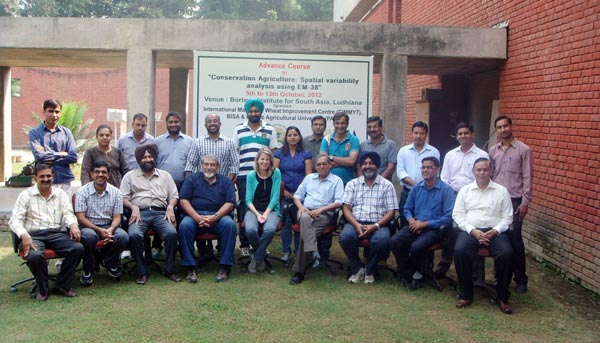CIMMYT and the Borlaug Institute for South Asia (BISA), in collaboration with Punjab Agricultural University (PAU), organized an advanced course on “Conservation agriculture and spatial variability analysis of soils using EM 38” in Ludhiana, India, during 5-13 October 2012. The course was attended by 15 scientists from 3 state agricultural universities (Jawahar Lal Nehru Krishi Viswa Vidyalaya, Rajendra Agricultural University, and PAU), Central Soil Salinity Research Institute, BISA (Jabalpur, Ludhiana, and Pusa), and CIMMYTIndia. It was inaugurated by Jaskarn Singh Mahal (PAU Additional Director of Research; Farm Mechanization and Bio Energy) and organized by Jill Cairns (CIMMYT-Zimbabwe), Raj Gupta and HS Sidhu (BISA), ML Jat (CIMMYT-India), and Yadvinder Singh and Ken Syare (CIMMYT). The course was supported by WHEAT Strategic Initiatives 2 and 3 (Sustainable wheat-based systems: Improving livelihoods while safeguarding the environment, and Nutrientand water-use efficiency).
The training was preceded by a brainstorming session to deliberate the design of the Long-term Research on Conservation Agriculture (CA) at three BISA sites. The session covered critical issues in major production systems, soil types, and agro-ecologies, and identified and prioritized future production systems for long-term CA trials. Component technologies and design protocols of long-term trials were discussed and finalized.
During the actual training, Cairns introduced the EM 38, the non-invasive, nondestructive, quick, and inexpensive sampling method using electromagnetic induction to measure salinity, moisture, and other characteristics of soil. Cairns then described the steps in EM 38 calibration, and the team worked on EM 38 surveys at a BISA farm in Ladowal. Participants were exposed to application of EM 38 in mapping spatial variation in fields with long-term and other trials and learned to generate maps from collected data. At the end of the session, maps generated by participants were presented and described, which was followed by a Q&A session.
As part of the course, HS Sidhu and the BISA Ladowal team provided a hands-on training on operation, calibration, and maintenance of CA-based planting machinery, including multi-crop zero till planter, raised bed planter, Turbo Happy Seeder, New Easy Seeder, relay crop planter, and high clearance tractor.

 Capacity development
Capacity development